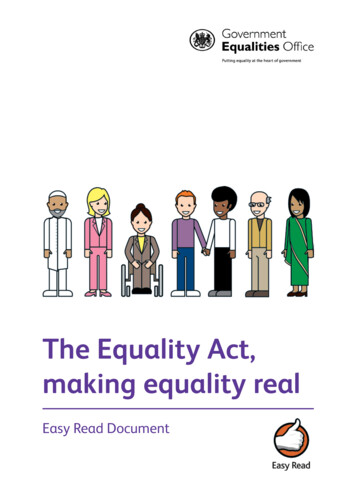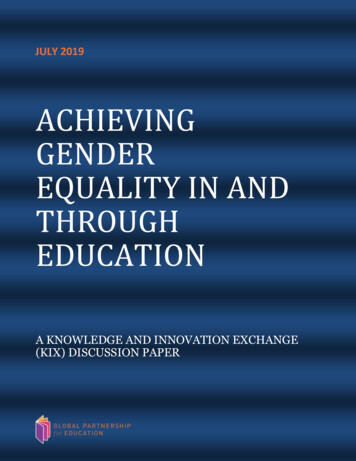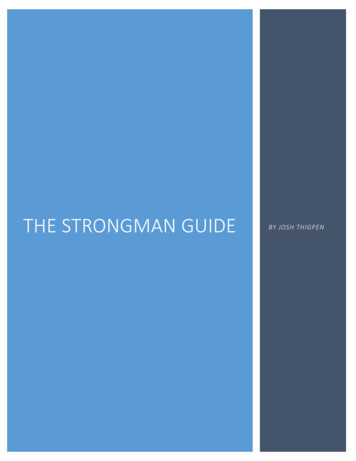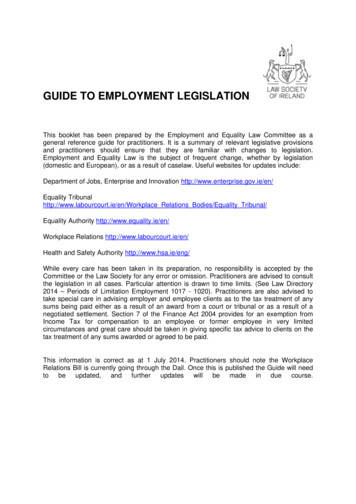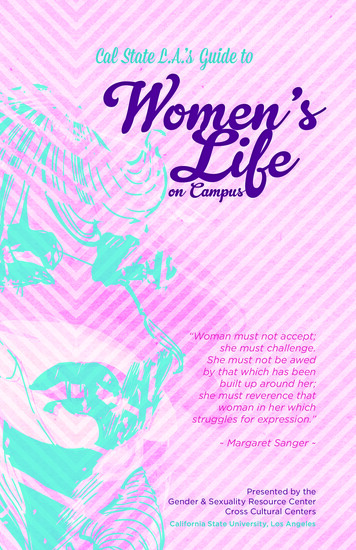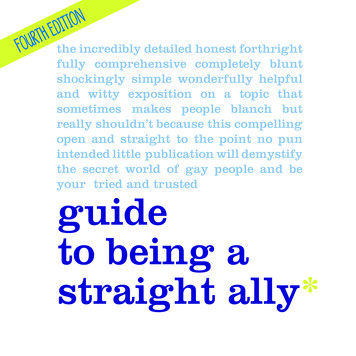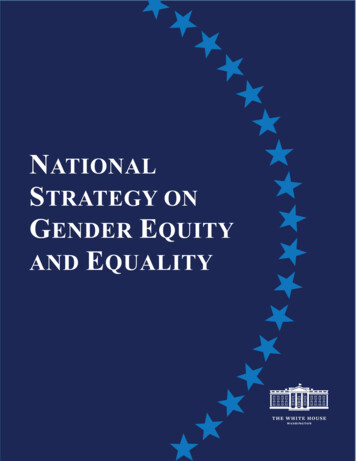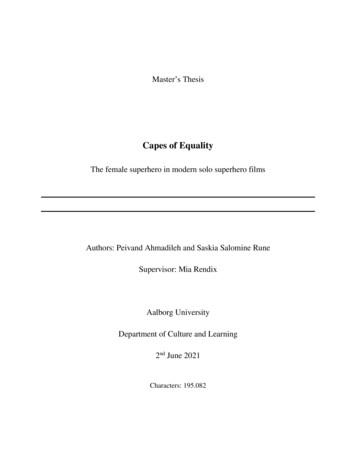
Transcription
Master’s ThesisCapes of EqualityThe female superhero in modern solo superhero filmsAuthors: Peivand Ahmadileh and Saskia Salomine RuneSupervisor: Mia RendixAalborg UniversityDepartment of Culture and Learning2nd June 2021Characters: 195.082
Ahmadileh & Rune 1Table of ContentsIntroduction2The Hero3Hero’s Journey4Heroine’s Journey8The Stereotyped Woman10Four Waves of Feminism12First wave13Second wave16Third wave19Fourth wave21Feminist Film Theory24The Male Gaze26A Female Gaze?28Analysis30Catwoman30Elektra38Wonder Woman43Captain Marvel52The Superheroine Subgenre59Discussion63Objectification, Sexualisation, and ‘What-aboutism’63Backlash Culture66Conclusion72Works Cited74Abstract87
Ahmadileh & Rune 2Introduction“Heroines are becoming more prevalent with more varied representations/portrayals in films,television shows, and video games. Heroines are sometimes simultaneously worshipped asgoddesses, reviled as villainesses, raped and beaten as victims, lusted after as sex objects,placed on pedestals as positive role models, and of course rescued as damsels. Some fightwith brute strength and weapons, while others seduce, love, lead, and resist nation. Aswomen were excluded from the hero’s journey, their roles and embodied meanings are, attimes, traditional, ambiguous, contested, and even controversial” (Jones et al. IX-X).Myths, legends, epics, television series, movies, and comic books. Heroes have been partof the stories we tell each other for millennia. From the Mediterranean Sea of Classical Greece tothe streets of New York in the 20th century; the hero remains recognisable. In present day, thehero can largely be found on the big screen in the form of characters who have become iconsthemselves. Iron Man, Superman, Batman, and Spider-Man, each with their own individualstories, characteristics, and abilities. Portrayals of female lead superhero solo films are scarce,however, to the degree of celebration once Wonder Woman premiered in 2017, and again twoyears later, when Captain Marvel (2019) entered the Marvel Cinematic Universe. Since whatJason Dittmer describes as a “superhero cinema boom” (Dittmer 115) post the events of 9/11,only two additional female led superhero films have premiered, Catwoman (2004) and Elektra(2005). In the midst of the now decade old franchises established with the two most recognisablesuperhero comic names, DC and Marvel, it is perhaps somewhat surprising to find trilogies ofBatman, Captain America, and Spider-Man films, some of which have experienced reboots morethan once since 2000, but no female superheroes aside from those appearing in ensemble films oras support of the male hero. What is seen of the female superhero or superheroine on screen fallinto certain tropes and/or stereotypes both in character and narrative, and the portrayal tends tolean into the male gaze. Catwoman, Elektra, Wonder Woman, and Captain Marvel, althoughbeing the only options of post 2000 female lead superhero films, provide insight to a shift in thegenre, where the female superhero has become more than what she is on screen alone, and wherethe conversation about this type of hero is veering towards progressive change rather thanstereotypical tendencies. Using a combination of feminist film theory and Campbell’s and
Ahmadileh & Rune 3Murdock’s Journey models, this paper is intended to examine the way in which four femalesuperheroes Catwoman, Elektra, Wonder Woman, and Captain Marvel are portrayed in narrativeand representation in their individual films. The effects of such narrative and representation onthe female body and mind will then be discussed in combination with the topic of maleobjectification and the inclusion of political discourse and/or messages in superhero films.The HeroThe concept and definition of a hero has varied and changed through oral and writtenhistory, even more so when the differences of mythical, epic, fictional, and real heroes are takeninto consideration. Consulting modern dictionaries of the word hero will give a variety ofdefinitions. In Cambridge online dictionary, a hero is “a person who is admired for having donesomething very brave or having achieved something great” and “the main character or the mainmale character in a book or film, who is usually good” (“Hero” Cambridge Dictionary). InMerriam Webster, a hero is defined similarly as “a mythological or legendary figure often ofdivine descent endowed with great strength or ability,” “an illustrious warrior,” “a personadmired for achievements and noble qualities,” “one who shows great courage,” and “theprincipal character in a literary or dramatic work —used specifically of a principal malecharacter especially when contrasted with heroine” (“Hero” Merriam-Webster). The variety ofdefinitions in and of themselves provide a window into the duality of the hero as something bothfictional or mythological and real, where the conditions and characteristics that are needed to befulfilled for the character or individual to be classified as a hero change, depending.Additionally, one definition in Merriam Webster emphasises that a hero is contrasted with theheroine, while hero is commonly used to refer to both genders in modern settings. As will beexplored, the differences of a hero and a heroine are indeed still present, despite how thesecharacters and individuals are referred to.Furthermore, the very concept of what a hero is has changed with time. According toPhillip G. Zimbardo et al., what is considered heroism is historically, culturally, and situationallydetermined, “thus heroes of one era may prove to be villains in another time.” (Zimbardo et al.99). For instance, while Achilles of Homer’s Iliad could be categorised among modernsuperheroes such as Wonder Woman or Captain America based on his prowess and partiallydivine origin, Achilles’ other characteristics and actions would not be considered ‘noble’ or
Ahmadileh & Rune 4‘good’ by the standards of a modern setting, the hero’s rage and the dragging of Hector’s bodyaround Troy, for example. Taking such circumstances into consideration regarding characterssuch as Captain America, changes in this character’s viewpoints and actions have been madewithin the past century to continuously fit into the mould and standards required of a modernhero. Corresponding with the notion that “heroism is a social contribution, never a personal one,”(Zimbardo et al. 99) which implies, to an extent, that heroes and heroines must, in one way oranother, not only act in a way that is considered heroic in the setting of their narrative, butlikewise in the setting of real life. Hero characters can then only be considered heroes, if they areconsidered heroes by the society who is at current experiencing their narratives. Regardingpopular culture, this notion must then apply to representation of character as well as narrative,since both are inseparably intertwined.Hero’s JourneyThe first attempt to categorise the heroes of myth into an archetype is attributed to LordRaglan with the book The Hero, A Study in Tradition, Myth and Drama from 1936, in whichRaglan proposes a list of 22 elements and traits based on hero myths from several differentcultures and religions to form the archetype of the mythic hero (Lord Raglan 178-179). Not all22 traits must be present, and not all are among every hero given as examples of this archetype inLord Raglan’s book, who includes Oedipus, Perseus, Moses, Watu Gunung, Sigurd/Siegfried,and Robin Hood. While Raglan does not deny the possibility that the origins of the hero mythscould be real, it is made clear several times that Raglan is convinced that such myths are indeedoverexaggerated, usually to emphasise a certain element in the narrative (Lord Raglan 178-179).In addition, Lord Raglan states that the more traits are present, the greater the chance is of thehero being mythical (Lord Raglan 189), and that when a hero “go beyond” the pattern presentedin his book, they may simply follow another, meaning diversion from the traits and pattern doesnot indicate a historical hero (Lord Raglan 201). Otto Rank had proposed 12 traits in his 1909book Der Mythus von der Geburt des Helden, different from Raglan’s in that Rank’s are based inFreudian psychoanalysis, and thus only apply to the first half of the hero’s life, involving thehero’s birth, adolescence, and young adulthood (Rank (intro essay by Segal) ix). The concept ofthe mythic hero, or the hero archetype, based on Rank and Raglan’s narrative patterns is known
Ahmadileh & Rune 5as the Rank-Raglan mythotype, and precedes the concept of the Hero’s Journey, or themonomyth, as proposed by Joseph Campbell in his 1949 book The Hero with a Thousand Faces.Campbell’s model is described as based on comparative mythology, and seeks, similarly,to Rank and Raglan’s models, to propose traits of the archetypical hero character’s journey.Campbell’s traits, or stages, differ from the preceding two proposals, as these take on a formcloser to narrative beats rather than characteristics of the hero. That is, Campbell’s stages aremore closely intertwined with the structure of the myth than the hero, whereas both Rank andRaglan contribute much of the myth’s structure to the character of the hero. For instance, whothe hero’s parents are, what interactions the hero has with their family, and other interpersonalrelations such as children and spouse. These traits are tied to the narrative of the myth, however,in a way that implies that the traits are inseparable from the narrative beat they are tied to, eventhough it is made clear that not all traits must be present. Campbell proposes a model of stagesthat more closely resembles the three-act-structure in the sense that they represent a point in thenarrative structure to which various occurrences can then be attached, depending on the nature ofthe myth.The Hero’s Journey consists of 17 stages, each representing a point in the narrative wherethe hero is challenged or achieves something. The first part of the journey is titled Departure andencompasses the first five stages, in which the adventure of the hero, and with it his eventualseparation from his current life, begins. The Call to Adventure acts as the inciting incident, wherean occurrence beyond the normal situation of the hero presents a call or opportunity for the heroto venture into the unknown. This stage is not necessarily characterised by fate, demand, orintention to have the hero begin the journey, but might equally be characterised by accident orforce (Campbell 48). Nonetheless, if the hero has the option, the opportunity or call is ofteninitially refused by the hero. Campbell notes that Refusal of the Call “converts the adventure intoits negative,” (Campbell 49) and whatever the hero chooses to do hereafter will only be adistancing of himself from “his Minotaur,” (Campbell 49) and creates a situation that onlyspawns new problems for and a “gradual approach of his disintegration.” (Campbell 49) Toavoid this fate, the hero must commit to the call of adventure, either consciously orunconsciously, whereafter a mentor character will appear. This Supernatural Aid takes the shapeof a benign magical guide, who will aid the hero through artefacts that will prove helpful later(Campbell 57), and through reassurance and promise that the journey is right and will present
Ahmadileh & Rune 6reward to the hero once completed, thus encouraging the hero to continue (Campbell 59). Withthe aid and encouragement of the guide, the hero now traverses the boundaries of his knownworld in the Crossing of the First Threshold, which represents the true beginning of the journeyinto the unknown and the adventure. Here, the hero will meet the “threshold guardian,” arepresentation of the danger that lies beyond (Campbell 64, 67-68). Finally, the hero is separatedcompletely from his known world by entering the Belly of the Whale. This stage not only acts asa transition, but a willing “form of self-annihilation” (Campbell 77) leading to a metamorphosisor rebirth of some manner. Although the hero displays a willingness to proceed, this stage ofteninvolves a hindrance, and the hero, “instead of conquering or conciliating the power of thethreshold, is swallowed into the unknown and would appear to have died” (Campbell 74).The second part of the journey is titled Initiation and consists of the next six stages withthe Road of Trials beginning as the hero steps over the boundary of the known and unknown.Within this stage, the hero journeys through the unknown world and is faced with trials that mustbe completed, although not all are completed successfully. What advice or artefacts the heroreceived from the Supernatural Aid will prove useful, or the hero may discover a “benign powereverywhere supporting him in his superhuman passage” (Campbell 81). The Meeting with theGoddess is the final trial where the hero finds himself “at the uttermost edge of the earth” or“within the darkness of the deepest chamber of the heart,” where he meets the goddess, or theQueen Goddess of the World (Campbell 91). Campbell describes the goddess as “incarnate inevery woman” (Campbell 99) and suggests that this character is a boon that must be won by thehero. Worth noting is, if the “adventurer” is a “maid” rather than a male hero, the adventurer’sdestiny is to “become the consort of an immortal. Then the heavenly husband descends to herand conducts her to his bed – whether she will or not” (Campbell 99). According to MaureenMurdock, Campbell expressed that a woman does not need to venture on a Hero’s Journey, asthe woman already finds herself in the place the hero is striving to be (Murdock 2).Women are given another role in the next stage, which is named Woman as theTemptress, although the temptation the hero meets here does not necessarily take the form of awoman. Essentially, this stage presents a temptation of life, where the hero is disillusioned froma tendency to “perfume, whitewash, and reinterpret” and the perception that the unpleasant partsof reality is the fault of someone else (Campbell 102). The disillusion comes in the form ofrevulsion when the hero realises how “everything is tainted,” (Campbell 102) which becomes a
Ahmadileh & Rune 7revulsion of “life, the acts of life, the organs of life, woman in particular as the great symbol oflife, become intolerable to the pure, the pure, pure soul” (Campbell 102). As the Hero’s Journeyis presented as a spiritual journey, the physical becomes a temptation the hero must surpass tosucceed. Here, as Campbell exemplifies, the woman becomes a metaphor for that physicaltemptation. In a similar yet very different way, the hero is then confronted with what Campbellcalls the father, with whom the hero must atone, hence the name of the stage being Atonementwith the Father or Abyss. To atone, the hero must surrender himself to the mercy of the terrifyingfather, a figure who holds incredible power, and through whose confrontation the hero willachieve an understanding of life, the abandonment of their ego, and the realisation that the fatherand mother are one and the same (Campbell 110). The mother referenced in this stage would bethe same female figure who aided the hero earlier. In this stage, the hero can rely on theprotection and comfort of the mother throughout the atonement with the father and in the case ofthe hero not being able to trust the mercy of the father, in which case they must trust the motherinstead (Campbell 110). Apotheosis, which occurs after the atonement, will allow the hero tocontinue his journey and face greater challenges, which in turn allows the hero to achieve thegoal of the journey, where he gains the Ultimate Boon. All previous trials have prepared the herofor this stage, as the boon is often something beyond even gods, and thus “its guardians darerelease it only to the duly proven” (Campbell 155).The third and final part of the Hero’s Journey revolves around the hero’s Return to theworld they initially came from. Here, the first stage echoes the Refusal of the Call since the heronow experiences a Refusal of the Return. Campbell notes that since the hero has now achievedhis triumph, his boon which may help or renew part of the community or world, he hesitates toreturn to the kingdom of humanity, in some cases doubting that the boon would be appreciated(Campbell 167, 170). In other instances, the hero is set into a Magic Flight, where he mustescape with the boon, chased by its guardians who do not want the hero to escape and return tohis own world. This type of flight “becomes a lively, often comical, pursuit,” which “may becomplicated by marvels of magical obstruction and evasion.” (Campbell 170). Rescue fromWithout can occur both in the instance of Refusal of the Return and the Magic Flight, as “societyis jealous of those who remain away from it.” (Campbell 178). If the hero refuses to return he“suffers an ugly shock,” but is rescued if he is merely delayed (Campbell 178). Upon theCrossing of the Return Threshold, the hero must retain the knowledge and experience he has
Ahmadileh & Rune 8gained in the other world and accept the existence of such a “soul-satisfying” world, while alsoaccepting the less satisfying realities of life. Returning with such knowledge may cause the heroto be viewed negatively by the community, he might “discover themselves playing the idiotbefore a jury of sober eyes” (Campbell 189). Instead of turning back, the hero must instead applywhat he has gained to life in his own world. Becoming a Master of the Two Worlds encompassesthe hero fully accepting and understanding the two worlds, often presented as spiritual andphysical, involving the dissolvement of his ambitions, letting go of the fear of self-annihilationand personal limitations (Campbell 204-205). At last, at the final stage of the Hero’s Journey, thehero has gained the Freedom to Live through the mastery. Largely, this involves the hero livingwithout regretting the past or fearing the future (Campbell 209).Heroine’s JourneyMurdock states in the introduction to her book The Heroine’s Journey: Woman’s Quest forWholesomeness (1990) that “Women do have a quest at this time in our culture. It is the quest tofully embrace their feminine nature, learning how to value themselves as women and to heal thedeep wound of the feminine” (Murdock 3). Murdock’s own model is in part based on Campbell’s(Murdock 3), but more specifically inspired from working as a therapist with women (Murdock1), and does not exclusively apply to the lives of women, nor all women (Murdock 4). TheHeroine’s Journey is, however, based on and meant to reflect the experience of women.Murdock’s book is moreover written as a self-help book, where Campbell sought to create amodel based on comparison of myths. Thus, it is more of a challenge to apply Murdock’s modelto narratives since it was not initially developed to be utilised in such a way.Like Campbell’s Hero’s Journey, Murdock’s Heroine’s Journey follows a progression ofstages, none of which are required to be present in all cases of the journey. Additionally, severalof the stages of the model proposed by Murdock can at times be experienced simultaneously orin differing orders (Murdock 4). The first stage for the heroine remains, however, the initiationprocess, the Separation from the Feminine. Beginning with a Rejection of the Feminine theheroine continuously experiences situations and completes acts, which separates her further andfurther from the feminine. Murdock argues that society is androcentric, and thus perceives theworld from the perspective of men. In such a society, women will view themselves as lacking in
Ahmadileh & Rune 9one or more ways when comparing themselves to men, and will, in an attempt at success, rejectwhat is considered feminine and womanly (Murdock 13-14). The very beginning of the journeyis “the heroine’s struggle to separate both physically and psychologically from her own motherand the mother archetype,” (Murdock 17) a process Murdock describes as particularly difficult,since it is, in a sense, equivalent to leaving a part of oneself behind. The steps that follow involvethe role of the Mother and how the heroine is influenced by internalising all the negativefeminine she experiences through her. Rejected by the Mother is the last step of this stage, whereMurdock describes the heroine’s search “for what she never had,” (Murdock 26) as a result ofthe Mother’s lack of nurture or presence. If this rejection takes place, the heroine may findherself in a perpetual daughter role, “looking for approval, love, attention, and acceptance” fromher Mother or another female role model (Murdock 26).Identification with the Masculine is the second stage, wherein the heroine seeks approvalfrom the Father, who acts as a further separation and freedom from the Mother and the feminine,which the heroine is working to reject. Here, heroines will be defined as Daughters of theFather, and the Father will be encouraging traits in the heroine that are typically praised in men,while discouraging feminine traits. During this, the second stage, after making the decision todistance herself from the feminine, the heroine “inevitably begins the traditional hero’s journey”(Murdock 36). This point is the Gathering Allies, where the heroine searches for role models andmale allies. If this ally is positive the heroine can continue in a positive manner, if not then theheroine may get held back by perfectionism and overcompensation (Murdock 38).The third stage is the Road of Trials where the heroine traverses the threshold in searchfor herself away from the safety and security of the known (Murdock 46). During this stage, theheroine will, similar to the Road of Trials in the Hero’s Journey, venture out to discover andlearn of her strengths and weaknesses. Here, she cannot blame any of the people in her life anylonger and must instead find her own path (Murdock 46). Different from the Hero’s Journey, theheroine will also face trials of inner conflict as well as external conflict. These types of trials willrelate to the Myth of Dependency, need, the Myth of Female Inferiority, and the Myth ofRomantic Love. At the end of this stage, the heroine will have experienced victories andencouragement which will lead her to the Illusory Boon of Success, where she achieves what shehas been working towards. After having reached her goal, the heroine understands that she hassacrificed and betrayed her own values during the journey, that her achievement “have come at
Ahmadileh & Rune 10too high of a price” (Murdock 69). The masculine traits she has learnt fail her and she feelsbetrayed, and she decides to turn away from the Father, a difficult decision because of thevalidation previously gained there (Murdock 84). A Spiritual Aridity is experienced where theloss of self happens (Murdock 74). Turning back begins the Initiation and Descent to theGoddess, a stage during which the heroine journeys to the belly of the whale, the underworld,often preceded by a life-changing loss (Murdock 87-88). “This journey to the underworld isoften filled with confusion and grief, alienation and disillusion, rage and despair” (Murdock 88).In this place, the heroine meets a goddess character representing what positive feminine valuesshe rejected, whereafter she can reconcile with it, which will inspire her to reconnect with thosefeminine values and traits, the Urgent Yearning to Reconnect with the Feminine. What theheroine has experienced on her journey thus far makes it impossible for her to return to her lifeas it was before. She will seek to reconnect with the feminine, “whether that be the Goddess, theMother, or her little girl within” (Murdock 111). The Healing of the Mother/Daughter Split, thesplit from the feminine, is the next step, where the heroine reclaims the feminine, leading to thenext stage, where she also needs to Heal the Wounded Masculine. Encompassed in this step is aninner conflict, the need for the heroine to understand the masculine parts of herself, to identifythe traits that aided her on her quest and those who betrayed her. Finally, is the Integration ofMasculine and Feminine, which echoes Campbell’s final step in the sense that two worlds areunderstood and accepted, which enables the heroine to exist in balance.The Stereotyped WomanCan female heroes exist if they are simply heroines? Or will archetypes and stereotypespersist in their character and narrative? Male heroes seemingly tend to be more freely able toexist as heroes in and of themselves, without the element of being defined by anything other thanthat. Jones et al. and Jobé. contain examples of this observation with the cases of the Bride in theKill Bill duology and Lara Croft of the Tomb Raider franchise. The Bride, who is only evernamed as such, is presented as a masculine hero who uses her skill to enact violence in her questfor revenge yet is defined by her female body and eventual role as a mother. Maura Grady arguesin Jones et al. that the Bride’s actions are undermined by the character’s victory, which is foundin enacting revenge on those who wronged her and taking her place as a mother. Throughoutmost of the film, the Bride is allowed to “play at the role of a male hero,” but is denied “the
Ahmadileh & Rune 11agency that a male hero would have because her biology determines her fate more than heractions” (Jones et al. 66). Lara Croft is inspired by the character Indiana Jones, both of them arearchaeologists venturing on dangerous journeys full of problems that are solved by their skill asarchaeologists as well as adventurers. Yet, the character is also defined by her female body andher role as the daughter of a greater archaeologist, which is especially evident in the early 2000’sfilms based on the videogames. The reboot series of the videogame franchise Tomb Raider,begun in 2013, introduces a less experienced, and less sexualised version of the protagonist, LaraCroft, who possesses more masculine traits in relation to violence. Still, the character is definedthrough the role of a daughter. Jobé proposes, in relation to the 2000’s films, that thissexualisation of a character so similar in archetype to one that is not represented in the samemanner, happens because Lara Croft cannot be an archaeologist without also being asupermodel. The character’s appeal to the male gaze enables her to also be intelligent andcapable (Jobé).In more than one instance does the body of the female character decide the narrative ofthe character. The Madonna-Whore Complex is the very concept that a woman can only beplaced in one or the other category, either in a position of the virgin (the child), or the whore (theseductress). While sex is not a part of this duality, it does force the character into a role of eitheror, where sexualisation and sex acts as unspoken or unseen traits of either virtue, passivity,benevolence, and chaste or vice, spite, appeal to the male gaze, and malevolence. No opportunityis left for the character to fill the archetype of the wife, where the characteristics of moralgoodness and sexual activity exist alongside each other (“Madonna-Whore Complex”). Thefocus on female characters’ bodies as defining features of their characters beyond being vesselsof their personality is commonly seen in archetypes, including the Bond Girl, the TrophyGirlfriend, the Dirty Old Woman, Femme Fatale, and Damsel in Distress. In these cases, thecharacter is often sexualised and/or utilises her body to manipulate or gain something from amale character, or, contrary, presented as undesirable and perhaps mentally unstable.When a female character, usually a female action hero, is to succeed she goes through aprocess of “masculinization or defeminization” (Bampatzimopoulos 208), where the traits of thecharacter are closer to stereotypical male traits. Additionally, they are physically closer to aneutral or masculine appearance, contrary to the sexualisation of characters such as Lara Croft.
Ahmadileh & Rune 12This implies that women must give up part of their person in favour of something better suitedfor the action and challenges at hand, or become hypersexual in appeal to the male gaze, to beallowed their capability. The stereotypical passive role of female characters cannot be applied inthe same manner in action films because the female character takes an active role to advance theplot (Bampatzimopoulos 207). Outside action films with a female protagonist, the malecharacters would be the active part who advances the plot, “while female characters function as apassive spectacle that pauses the narrative and offers pleasure both to the male gaze of theprotagonist, as well as the patriarchal gaze of the audience” (Bampatzimopoulos 207). The veryaction of gazing can be considered a desire reserved for men, thus, whenever a woman holds thatdesire and attempts to gaze, it poses a threat “both to the male character and the male spectator,since they sense the symbolic danger of castration,” and the female character must therefore be“either punished or subjected to the male protagonist” (Bampatzimopoulos 207).Four Waves of FeminismFeminism as a term can be difficult to define, because as a movement, it can campaignfor multitudes of issues and topics, including voting, maternity leave, work and earning, accessto legal abortions, protection from sexual harassment and domestic violence amongst other,though the emphasis placed on these different issues and topics have varied throughout thehistory of the feminist movement. Modern western feminism is usually divided into generationsor periods, or as it is more commonly acknowledged as, waves. At the current time, four waveshave been recognized with the first wave having its beginning in the 19th century. The worditself derives from the French word féminisme, coined by French philosopher and socialistFrançois Marie Charles Fourie
Capes of Equality The female superhero in modern solo superhero films . Captain Marvel 52 The Superheroine Subgenre 59 Discussion 63 Objectification, Sexualisation, and ‘What-aboutism’ 63 . determined

